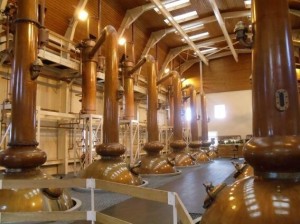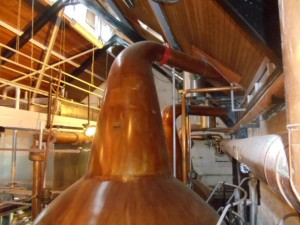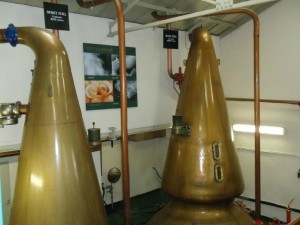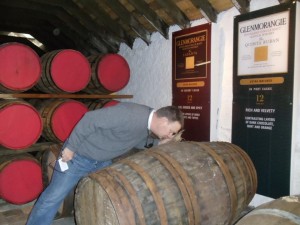 Today we have a guest post from Spirits Educator Russ Kempton, CSS. Russ shares with us some of what he learned about Scotch whisky during his five trips to Scotland!
Today we have a guest post from Spirits Educator Russ Kempton, CSS. Russ shares with us some of what he learned about Scotch whisky during his five trips to Scotland!
Impersonal – that’s how I would describe most of the distilleries in the world. However, the opposite is true for the distilleries located in Scotland. Do other regions and countries have long and just as distinguished history in producing distilled spirits? – Yes; but I feel that for the romance and the mythology, there are none like the Scotch whisky distilleries.
Rugged, rustic, and remote outposts describe most of Scotland’s distilleries in operation today, not one alike and all unique. Scotland’s unique, complicated, eco-system produces exceptional, tradition-rich whiskies. Due to this environment, Scotch whisky is among the most diverse spirits in the world.
Since the mid 1800’s, the debate among whisky drinkers has been which type of Scotch whisky is the complete spirit – single malts or blends? Single malts epitomize the distilleries signature as to what can be produced at a single distillery, while the blended whiskies style come from the vision of the Blending Houses.
 To be classified as a single malt Scotch, these requirements must be met; distilled from 100% malted barley, a product of one distillery, produced exclusively in Scotland, aged a minimum of 3 years in oak barrels, and placed into the bottle at no less than 80 proof or 40 alcohol by volume. Single Malt Scotch has three basic ingredients; malted barley, water and yeast with the color coming from the oak during maturation.
To be classified as a single malt Scotch, these requirements must be met; distilled from 100% malted barley, a product of one distillery, produced exclusively in Scotland, aged a minimum of 3 years in oak barrels, and placed into the bottle at no less than 80 proof or 40 alcohol by volume. Single Malt Scotch has three basic ingredients; malted barley, water and yeast with the color coming from the oak during maturation.
Blended Scotch will come from whisky produced at many distilleries with the majority (average 60%) being distilled from various grains such as unmalted barley, maize, and wheat. The grain whisky in the blend must be aged a minimum of three years and aged to the label year, if the blend carries an age. The remainder of the blend will contain, on average, approximately 35 to 40 single malts.
Blended Scotch of higher quality and price will carry a higher concentration of single malts in the blend. Blends on the opposite end of the scale will carry more grain bringing the quality and price down. The blender wants their whisky to be consistent for their loyal consumers. For this reason, they strive to produce a whisky which has a distinguishable quality and characteristic.
 Many Scotch whisky distilleries are located in the mountains or glens, near rivers, lochs, or along the coast. The four seasons and weather in the areas will affect the barley, fermentation, distillation, and maturation at the distillery. During maturation the oak barrels and casks “breathe” the local air simply because the barrels are watertight but not air tight. For example, whisky aged in warehouses by the sea will pick up definite maritime qualities, therefore affecting the finished whisky and giving it the signature from that specific region.
Many Scotch whisky distilleries are located in the mountains or glens, near rivers, lochs, or along the coast. The four seasons and weather in the areas will affect the barley, fermentation, distillation, and maturation at the distillery. During maturation the oak barrels and casks “breathe” the local air simply because the barrels are watertight but not air tight. For example, whisky aged in warehouses by the sea will pick up definite maritime qualities, therefore affecting the finished whisky and giving it the signature from that specific region.
There are five steps to a finished product: malting, mashing, fermentation, distillation, and maturation.
MALTING: Barley is germinated during this step, converting the starches into fermentable sugars. It is then arrested by drying the barley in a kiln, usually over a peat fire, for 24 – 36 hours. The longer in the kiln, the more smoke influence in the finished product. Peat is simply decomposed plant life, usually heather. Before being used in the kiln, the peat is pressed and dried.
MASHING: The dried grain, now known as malt, is milled into a coarse flour called grist. The grist is then mixed with hot water in a mash-tun where the conversion of starch into sugar is completed. This sugary liquid is now known as wort. The wort is next transferred into huge vats (washbacks) for fermentation.
F ERMENTATION: Yeast (unique to each distillery) is added to wort. The sugars in the wort are converted into a low-proof alcohol known as wash. This process takes 48 – 72 hours (average), some distilleries fermentation cycles are lower or higher.
ERMENTATION: Yeast (unique to each distillery) is added to wort. The sugars in the wort are converted into a low-proof alcohol known as wash. This process takes 48 – 72 hours (average), some distilleries fermentation cycles are lower or higher.
DISTILLATION: The Wash is put in copper pot stills and distilled twice. The first distillation is the wash still with the spirit vaporizing, condensing to produce low wines. The second distillation in the spirit still consists of three cuts; only the middle- the heart- of the run is pure enough for maturation. The usable spirit is called “new make spirit” and sent on for maturation.
MATURATION: The new make spirit is aged in oak barrels or casks for a minimum of three years and starts to pick up its color and flavor profile. A ten-year maturation or longer period is typical for single malts of high quality. During aging, 1% – 3% of the spirit will evaporate each year; this is simply known as the “angel’s share”. Oak barrels or casks play a significant role during maturation; as much as 60% of the whisky’s flavor comes from the wood influence. Some distilleries use only sherry casks in their maturation process; however the vast majority will use used bourbon or Tennessee whiskey barrels since bourbon and Tennessee whiskey can only be produced in new charred oak barrels.
 The Scots in the whisky industry are highly dedicated to their heritage, passionate about quality and committed to excellence. All of this magic is fused from three basic ingredients, time, place, and environment.
The Scots in the whisky industry are highly dedicated to their heritage, passionate about quality and committed to excellence. All of this magic is fused from three basic ingredients, time, place, and environment.
Slainte Mhath! (pronounced Slan-Je-Va) – meaning “good health to yours” in Gaelic.
Russ Kempton, CSS, is a Distilled Spirits Educator conducting spirits education, training, seminars, tastings, events, dinners, and consulting throughout the United States. He also holds the Certificate of Expertise in the Sales & Service of Scotch Whisky, received in Edinburgh on one of his 5 journeys to Scotland.
Click here to return to the SWE Homepage.
Pingback: Tucson pork & scotch, wine, tequila and beer dinners | Circle of Food